I’m fascinated by the sense of “order” displayed by the hierarchy of door design throughout my 1830s house. Much is due to economics, of course, with the less complicated woodworking used in the less formal spaces.
Still, this is just a simple farmhouse, so it’s amazing that in the era of hand tools, there existed such a desire to incrementally dress-up the more formal rooms.
This first and “highest order” door design is in the West Parlor (for now I’m only addressing the doors themselves, not the surrounds). Two-step raised panel with molding:
The next is in the East Parlor. One-step raised panel with molding:
This design is used in the bedrooms and dining room. Flat panel with molding:
Inside storerooms and the backside of the basement door, there are flat panels with no molding:
For a thin (1 1/4 inch) closet door, the panels are beaded, and rabbited on the sides, top and bottom:
The variations in door surrounds is interesting, too. The East Parlor woodwork, while more complex and sophisticated to my eye, was presumably considered less formal, as it’s paired with the “Second Order” of door design.
And … dial-uppers rejoice! I’ve finally learned how to create very small, but reasonable-quality jpegs. I feel bad for having posted so many 80K and 100K photos in the past.
Allen (fellow dial-upper)
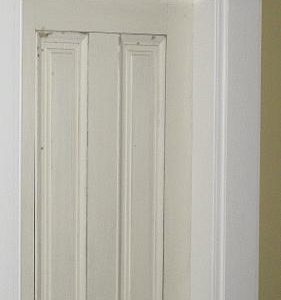
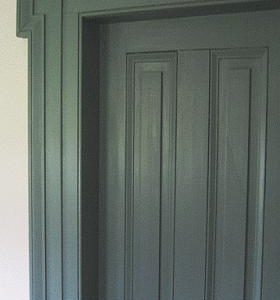
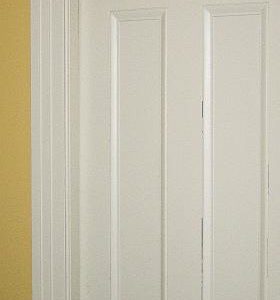
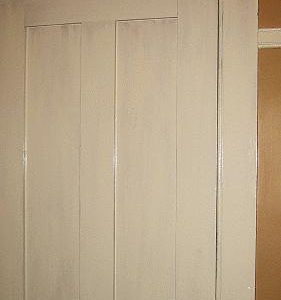
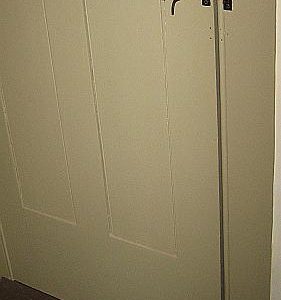



















Replies
That is very interesting. Thanks for showing them. I really like the surround on the East parlor, don't see many like that!!!
The whole idea makes me hate the hollow cores in my little ranch..........
Yes, the East Parlor trim is my favorite, also. I had to re-create quite a bit of it to restore the surround to a five-foot-wide niche that was walled over in the 1870s.
There was a thread recently about cutting miters in the wrong direction. There's actually an example of that mistake in my East Parlor. An additional triangular section was carefully pieced in to make the correct "turn." It was difficult enough work that the carpenter decided not to hand-plane an entire new length of molding to correct his mistake!
Allen
Allen,
Looks good. I did a home in Lewes DE in the 80's that was built pre revolution that had similar trim details to the second pic (East Room) Is that door header called a Greek Key?
Chuck Slive, work, build, ...better with wood
Chuck, there is a term for that, but I can never bring it to mind.
Not "Greek Key," though, as that refers to an interlocking repeated square motif often used in decorative borders. Here are a couple variations:
View Image
Here's another view of the East Parlor:
View Image
That door opens to a front porch. Well, it would if I had a key. It hasn't been opened during the 11 years I've been here. When I finally opened the main front door, I found newpapers from the 1940s stuffed around it (the previous owners had a board over the exterior).
Here's the East Parlor from the outside (behind porch). West Parlor is to the left:
View Image
Allen
Allen,
Thanx for the info.
My Sister is at Mcgill. I love the drive through 1000 Islands and Stay in Waterloo when I'm not in a hurry or Watertown when I am.
Chuck Slive, work, build, ...better with wood
I'll add another vote for the east parlor trim. Really like that waiscoting or window panels..or whatever they're called. But I'd hate to have to replicate that trim, looks like a PITA!
View Imagejt8
"We ourselves feel that what we are doing is just a drop in the ocean. But the ocean would be less because of that missing drop."-- Mother Teresa
The term "Atticurge" is used for that door surround treatment. The root word is "Attica," I believe, as in ancient Greece.
However, I've also read that the term can refer to a door surround with tapering jambs (wider at the bottom).
This is from ancient Greece:
View Image
And this is from ancient Rome:
View Image
Allen
Allen,
Here are some bad pics from the mid 80's. I restored this home in Lewes DE at "Ship's Carpenter's Square" Once again sorry for the bad pics. I had scanned them several years ago and am on a different computer. Here is the Greek Key back band.
View Image
We also site built the arches.
View Image
This is the view from the family room to the dining room. The Painters used hot mud and oakum to fill in the gaps. All paint grade C & Btr Pine
View Image
This is the family room fireplace.
View Image
Here is the 1740's house. The house 2 doors to the right was built by a signer of the US Conststitution. Either Richard Basset or George Read
View Image
Chuck S
live, work, build, ...better with wood
Chuck, thanks for sharing those. All new woodwork? Based on the original, or an interpretation of what might be appropriate?
In any case, beautiful work. One great thing about using Classical models is their timelessness. You did that 20 years ago, but it doesn't look "dated" like a lot of stuff done in the 80s.
Also appreciated your wainscotted bathroom in the other thread.
Allen
Allen,Thanx. That house was down to the studs. We only did the trim. All new site fabricated millwork and they ended up painting it. I basically moved there for the summer. Brought my contractors saw, 8' long bed joiner and 14" band saw. The house is owned by a DC doctor and his partner. Doc had the idea of stopping the arch short. The millwork was replicated from other homes of that era.We also did work on his Georgtown brick Victorian. Built a porch on the back that was all- heart redwood VG and select & btr Douglas fir. Built the arches on the front porch.http://forums.taunton.com/tp-breaktime/messages?msg=79773.234 Chuck Slive, work, build, ...better with wood
Chuck, I've been following your "small addition" thread. Great stuff, there. I'm glad I got in "on the ground floor" with it.
The "adverse conditions" thread was about a thousand posts long before I realized I was missing something good ... and haven't been able to commit enough time to "catch up." Aaargh.
Allen
Allen,
The more I think about that house in Lewes DE I worked on, the original interior would have probably been shiplap planked with minimal trim details. Doc chose 6 panel doors which would not even been around back then. Your plank doors and 2 panel doors look authentic.
Glad you are enjoying small addition. I know you realize that it is hard to stop and take pics in the middle of trying to get work done.
Chuck Slive, work, build, ...better with wood
"Glad you are enjoying small addition. I know you realize that it is hard to stop and take pics in the middle of trying to get work done."
Indeed!
Regarding the six-panel doors, I've seen a lot a variations in early door design. The doors in Lewes have undeniably modern-looking proportions, but their so-called "Cross and Bible" design has a long history. Whoever coined the term saw a cross formed by the frieze rail and muntin, and the bottom panels as an open book.
Regarding Greek Keys, here are a couple Asher Benjamin examples from his 1830 The Architect, or Practical House Carpenter. The first is a front doorway which incorporates the Greek Key motif on the lock rails of the front doors, and a variation on the flanking pilasters.
The second example is a window lintel.
View Image
View Image
Allen
Allen,Thanx for that info. I called Doc today (he is now 87 and still practicing 2 days a week) and he said it was Greek corners that he specified, not Greek keys. He went on to describe Greek keys as exactlly what you posted. Upon further discussion of that house, Doc and I decided it was more of a renovation than restoration. The exterior of that house was redone in ceder shakes. The original would hve been hand split, either white oak or cyprus. This thread has developed into something all of us who live in, love and respect old houses can appreciate. I hope more people who have owned or worked on Historic properties respond. Thanx for starting this thread.Chuck Slive, work, build, ...better with wood
Always good to hear I'm not the only one that cuts the miters in the wrong direction. That sure does get expensive!!
Hows the wind out west?? Gusting well over 40 here in Massena!!
It's windy and rainy, but not as severe as you have it up there in the North Country. My wife was up your way (Potsdam) last week, and the forecast was for a foot of snow. Luckily, that didn't materialize!
Allen
Edited 4/16/2007 8:08 pm ET by WNYguy
We refer to our parlors as East and West also, but I have heard people call them "the ladies parlor" and "the gentleman's parlor". Is that a common nomenclature in your area?Our west parlor is more formal (cast plaster crown molding and the tile extends into the firebox) than the east parlor, and the west parlor only has one entrance, from the hall. The east parlor connects not only to the hall, but to the dining room as well, which connects to the butler's pantry and then the kitchen.I've always figured the west parlor was a receiving room, but someone said gentlemen would retire to the gentlemen's parlor to smoke.
"the ladies parlor" and "the gentleman's parlor"
I've heard those terms. Also "drawing room" (short for "withdrawing room") and "receiving room." I have an 1877 pattern book that labels two parlors as "parlor" and "sitting room."
The stories I hear are that the formal parlor was used to receive the pastor when he visited, and to lay out the body when someone died. I'm fascinated by the day-to-day details of 1830s life, but don't know whole lot. Still learning.
My earlier pattern books are currently "out on loan," but I seem to recall the term "living room" being used a lot earlier than I had presupposed.
I don't know the common terms used in this area back in the 1830s, or even exactly how the rooms were used on a daily basis. I discussed that topic briefly with the man who lived here from 1913 to 1986, and he described closing off the West Parlor in the winter time. And in the summer, they would remove the remove the coal stove from the East Parlor.
Anyway, around here, folks just say "living room" and "family room." But "parlor" sounds so much better!
Allen
"... west parlor only has one entrance, from the hall. The east parlor connects not only to the hall, but to the dining room as well, which connects to the butler's pantry and then the kitchen."
That's exactly true of my house, also. BTW, I'd love to see some photos of that plaster and tile work.
Allen
does the 'north wing' predate the rest of the house? - In our area (north central IN) it is common for the oldest part of the structure to be a two room, single story, with the larger part added on later as time and money allowed -
27256.1 is a link to a pictorial about just such a circumstance -
"there's enough for everyone"
David, what you describe is common here, as well. But in this case, the house was originally built in its current configuration.
The constrution method is unusual -- stacked plank -- so it's easy to determine this. Besides the fact that this technique had a rather short span of popularity, the planks at the wall intersections are interlaced. No way to go back and do that at a later date!
That's a very cool house in your link, BTW.
Allen
Allen,
Your house looks awesome...Very nice restoration job! The exterior trim work looks great. I wish the previous owner of my house hadn't considered J channel trim!
Does the hierarchy change between the 1st floor and the 2nd floor, too? Are there differences in the quality / style of flooring?
Dave
Dave, thanks. I included a photo of an upstairs bedroom door: flat panel with applied molding. That's the same as the dining room. The surrounds upstairs are sort of a two-step backbanding:
View Image
Floors are random-width pine upstairs. Chestnut in Dining Room and East Parlor. Basswood, I think, in the West Parlor, but that rotted and was at some point replaced with fir.
There are two small rooms that still have basswood floors. But much of that has turned to powder. Only one room still has it intact, and it's really a beautiful wood. Apparently not very durable, though.
Allen
Edited 4/18/2007 2:50 pm ET by WNYguy
Lets see how this worked. Sorry about the file names. Our house is newer, 1901. I don't have that particular fireplace, but I've included some others. The wallpaper frieze and picture rail we added in the East parlor. It's our formal parlor. The west parlor is where the TV is now. It has the plaster molding. We may change the color at some point.
Bryan,
Nice work. The bevelled mirrors ar from a bygone era.
Chuck Slive, work, build, ...better with wood
Bryan, very nice. There's something about "natural" woodwork that is so appealing. Although my interests and research have tended toward the early 19th century, I have a great fondness for many early 20th century details. Your Arts&Crafts wallpaper frieze is beautiful. My wife and I were married at the Roycroft Inn in East Aurora, N.Y., and we both really appreciate that aesthetic.
The plaster molding is very appealing, also. Thanks for sharing.
Allen
We have considered repainting the plaster crown. What have you seen in the way of paint treatments? We are considering anything from going with an antiqued stainless look (to match the ceiling fan) to painting in the detail on the molding. It's about a 3' repeat of fruit.
I'm not very familiar with plaster crown color treatments from that period. I'll look around for information on possible options, though.
Allen
You've brought up a subject that, for me, point out one if the differences that "quality" homes no longer display.
In my 1950 home, all of the doors are 6 panel. Even the one in the closet door under the main stairway -- and it's probably only 70" tall. And even the one in the under-stair cubby - and I'll bet it's less than 30" tall.
All are 6-panel, and all have been made to the proper proportion.
Support our Troops. Bring them home. Now. And pray that at least some of the buildings in the green zone have flat roofs, with a stairway.
I've seen this a lot in old houses, usually reflecting either new work done later on or budgeting fancy carpentry work for more important rooms and saving a buck by applying the plainer more economical finish work to the service/utility areas, servant areas and out of way places. Very common.
You're correct, of course; it's certainly not uncommon. I enjoy the cues regarding the "importance" of each room, and the visual richness of having such variations around me every day.
Allen
Yup, that's what's cool about old houses and why I've lived in nothing but all my life, its like living inside a history book that has a story to tell every time you take a minute to really look.
I'm not positive, but I think that East parlor trim detail is from the Italianate period, from roughly 1850 to 1870. Was that ell an add-on to the original house?
Woodguy, that is a very common design during the Greek Revival period. It's definitely not Italianate, though I recall seeing some similar treatment in Italianate houses.
Except for a small woodshed attached to the north wing, the house retains its original footprint. That's one of the things that attracted me to the house in the first place, after previously struggling with the restoration of an 1820 house that had been expanded in every direction.
There were, however, a couple of alterations to this house during the Italianate period. Doorways from the front hall to each parlor were made wider and taller, with double doors hung in each location.
I have since brought both down to the original height. I left one doorway wide, but at least moved the south jam back to its original location ... which was easy to see, as the 1870s plasterwork was not very refined.
Here's a shot showing the new (partially restored) location framed. The Italianate-period door location can be seen here, too (taller and to the left); the Italianate doors to the East Parlor are behind the plastic in the background:
View Image
Speaking of footprints, here's the north wing (single-story at right --kitchen/dining). I added the porch -- it's historically appropriate in its location, but this house didn't originally have one there. The far-right window is original; I used salvaged windows and made the more appropriate door (see "before" shot):
View Image
Allen
By the way, in my last post, the photo of the west parlor doorway also shows some of the stacked plank that makes up the exterior and most of the interior walls. The plaster was applied directly to the one-inch thick planks, which were stacked and nailed to form the structure of the house.
This was the topic of a couple previous discussions here at Breaktime.
Allen
Here are a few Greek Revival examples of similar window/door surround treatment to what's in my East Parlor. I have some hardcopy examples, locally, from the 1830s, but no scanner.
This first variation is actually from an 1824 Federal-style house. A built-in cupboard:
View Image
Here's a couple New York State examples from the 1840s:
View Image
View Image
And a few from Ohio:
View Image
View Image
View Image
View Image
And, finally, exteriors of some of those houses:
View Image
Not surprisingly, the Niagara County example is the most similar to my house. That's the next county east from here.
OK, I've gotta get back to my real work!
Allen